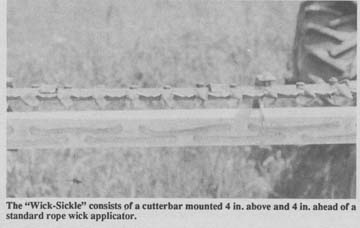
Opening up tall-growing weeds with a sickle bar before wiping them with Roundup is one of those simple ideas that seem like common sense but the actual idea for it grew out of years of research, according to Scott Glenn, a weed scientist at the University of Maryland who came up with the idea as a logical result of a long-term research project.
Glenn had been studying the translocation of chemicals by plants and discovered that when you cut off the top of a weed, you trick it into putting down more roots in order to survive. That draws resources from the rest of the plant down to the bottom of it. If you wipe a herbicide onto the plant right after cutting it, it'll be drawn quickly down through the entire plant, killing it much faster that it would if it had to work its way through the intact leaves and stem.
The "Wick-Sickle" consists of a cutter-bar mounted 4 in. above and 4 in. ahead of a standard rope wick applicator. The weed-killing combo mounts on a front end loader so it can be raised and lowered to run just above the top of the crop to cut off tall-growing weeds and volunteer corn.
"We get 20 to 30% better control of Johnsongrass and other weeds. Another advantage is that the tops of the weeds are cut off so they can't compete for sunlight with the crop. If you just wipe them, the weeds can die but still stand upright, competing with the crop for sunlight," says Glenn, noting that he expects wick applicators to make a big comeback in the next few years because of the expense of selective post emergent herbicides.
Glenn powers the loader-mounted cutterbar with a hydraulic motor and simply made brackets to hang the rope wick applicator below it. He is currently doing research to determine whether simply scraping or somehow injuring weeds will work just as well as cutting it off to get chemical into the plants faster. If so, a less-complicated mechanism, such as rotating wires or blades, might be used in place of a cutterbar.
